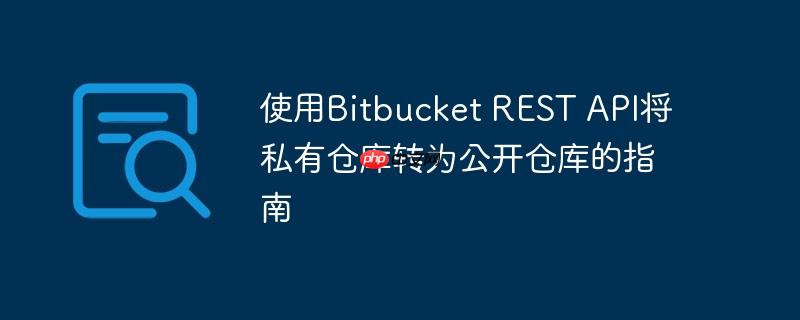
在Bitbucket中,仓库的可见性(私有或公开)是一个核心属性,有时我们需要通过自动化脚本来批量修改或根据特定条件调整仓库的可见性。Bitbucket提供了强大的REST API,允许开发者以编程方式管理其资源,包括仓库属性。本文将深入探讨如何利用Bitbucket REST API将一个私有仓库转换为公开仓库,并解决在实践中可能遇到的常见问题。
Bitbucket REST API是Bitbucket云服务提供的一套接口,允许外部应用程序与Bitbucket进行交互。对于修改仓库属性,我们通常会使用PUT方法向特定的仓库资源URL发送请求。修改仓库可见性,即将其从私有(is_private: True)更改为公开(is_private: False),需要向以下端点发送PUT请求:
https://api.bitbucket.org/2.0/repositories/{workspace}/{repo_slug}
其中,{workspace}是你的Bitbucket工作区ID,{repo_slug}是仓库的唯一标识符(通常是仓库名的小写形式)。
在尝试将私有仓库设置为公开时,一个常见的错误是收到400 Bad Request响应。这通常意味着请求体中缺少了API期望的关键参数。以下是一个可能导致此错误的初始尝试代码示例:
import requests
# 替换为你的Bitbucket凭据和仓库信息
username = 'your_username'
password = 'your_password_or_app_password'
workspace = 'your_workspace_id'
repo_slug = 'your_repository_slug'
base_url = 'https://api.bitbucket.org/2.0/'
session = requests.Session()
session.auth = (username, password)
headers = {
'Content-Type': 'application/json'
}
# 尝试将仓库设置为公开,但可能导致400错误
data = {
"type": "repository",
"is_private": False
}
url = f'{base_url}repositories/{workspace}/{repo_slug}'
res = session.put(url, json=data, headers=headers)
print(f"响应状态码: {res.status_code}")
print(f"响应原因: {res.reason}")
print(f"响应内容: {res.text}")当执行上述代码时,即使认证信息正确,也可能得到<Response [400]> Bad Request。这表明除了is_private字段外,Bitbucket API在将仓库设为公开时,还需要一个额外的参数:fork_policy。
Bitbucket在将仓库设置为公开时,强制要求明确其分叉策略。这是为了确保公开仓库的行为符合预期。fork_policy参数定义了该仓库是否允许被分叉,以及如何分叉。常见的fork_policy值包括:
要解决400 Bad Request错误,我们需要在请求体中添加fork_policy字段。通常,将公开仓库设置为允许分叉是最常见的需求,因此可以将其设置为allow_forks。
修正后的请求体示例如下:
data = {
"type": "repository",
"is_private": False,
"fork_policy": "allow_forks" # 关键的修正
}以下是包含所有必要参数和错误处理的完整 Python 脚本,用于将Bitbucket私有仓库转换为公开仓库:
import requests
import json
def change_bitbucket_repo_visibility(username, password, workspace, repo_slug, is_private=False, fork_policy="allow_forks"):
"""
使用Bitbucket REST API更改仓库的可见性。
Args:
username (str): Bitbucket 用户名。
password (str): Bitbucket 密码或应用密码。
workspace (str): Bitbucket 工作区ID。
repo_slug (str): 仓库的slug(通常是仓库名)。
is_private (bool): 目标可见性,True为私有,False为公开。
fork_policy (str): 分叉策略,当is_private为False时必须提供。
可选值: "allow_forks", "no_public_forks", "no_forks"。
Returns:
bool: 操作是否成功。
"""
base_url = 'https://api.bitbucket.org/2.0/'
url = f'{base_url}repositories/{workspace}/{repo_slug}'
session = requests.Session()
session.auth = (username, password)
headers = {
'Content-Type': 'application/json'
}
payload = {
"type": "repository",
"is_private": is_private
}
# 如果设置为公开,则必须提供fork_policy
if not is_private:
payload["fork_policy"] = fork_policy
try:
print(f"尝试将仓库 '{repo_slug}' 设置为 {'私有' if is_private else '公开'}...")
res = session.put(url, json=payload, headers=headers)
res.raise_for_status() # 如果请求失败(非2xx状态码),则抛出HTTPError
print(f"成功更改仓库 '{repo_slug}' 的可见性。")
return True
except requests.exceptions.HTTPError as e:
print(f"API请求失败: {e}")
print(f"状态码: {res.status_code}")
print(f"原因: {res.reason}")
try:
error_details = res.json()
print(f"错误详情: {json.dumps(error_details, indent=2)}")
except json.JSONDecodeError:
print(f"响应内容: {res.text}")
return False
except requests.exceptions.RequestException as e:
print(f"请求过程中发生错误: {e}")
return False
if __name__ == "__main__":
# 请替换为你的实际信息
BITBUCKET_USERNAME = 'your_bitbucket_username'
BITBUCKET_APP_PASSWORD = 'your_bitbucket_app_password' # 推荐使用应用密码而非账户密码
TARGET_WORKSPACE = 'your_workspace_id'
TARGET_REPO_SLUG = 'your_repository_slug' # 例如: 'my-awesome-repo'
# 示例1: 将仓库设置为公开
print("\n--- 示例1: 将仓库设置为公开 ---")
success_public = change_bitbucket_repo_visibility(
username=BITBUCKET_USERNAME,
password=BITBUCKET_APP_PASSWORD,
workspace=TARGET_WORKSPACE,
repo_slug=TARGET_REPO_SLUG,
is_private=False,
fork_policy="allow_forks"
)
if success_public:
print(f"仓库 '{TARGET_REPO_SLUG}' 已成功设置为公开。")
else:
print(f"未能将仓库 '{TARGET_REPO_SLUG}' 设置为公开。")
# 示例2: 将仓库设置为私有 (可选,用于测试反向操作)
# print("\n--- 示例2: 将仓库设置为私有 ---")
# success_private = change_bitbucket_repo_visibility(
# username=BITBUCKET_USERNAME,
# password=BITBUCKET_APP_PASSWORD,
# workspace=TARGET_WORKSPACE,
# repo_slug=TARGET_REPO_SLUG,
# is_private=True
# )
# if success_private:
# print(f"仓库 '{TARGET_REPO_SLUG}' 已成功设置为私有。")
# else:
# print(f"未能将仓库 '{TARGET_REPO_SLUG}' 设置为私有。")通过Bitbucket REST API将私有仓库转换为公开仓库是一个相对简单的过程,但需要注意fork_policy这一关键参数。通过在PUT请求的JSON负载中正确设置is_private: False和fork_policy: "allow_forks",并结合适当的认证和错误处理,你可以轻松地实现仓库可见性的自动化管理。这对于需要大规模管理Bitbucket仓库或集成到CI/CD流程中的开发者来说,是一个非常有用的功能。
以上就是使用Bitbucket REST API将私有仓库转为公开仓库的指南的详细内容,更多请关注php中文网其它相关文章!

每个人都需要一台速度更快、更稳定的 PC。随着时间的推移,垃圾文件、旧注册表数据和不必要的后台进程会占用资源并降低性能。幸运的是,许多工具可以让 Windows 保持平稳运行。

Copyright 2014-2025 https://www.php.cn/ All Rights Reserved | php.cn | 湘ICP备2023035733号